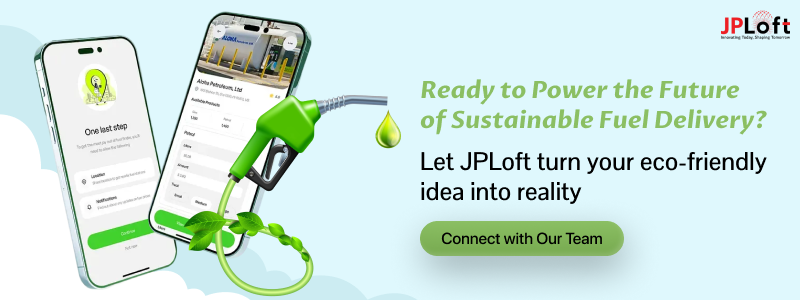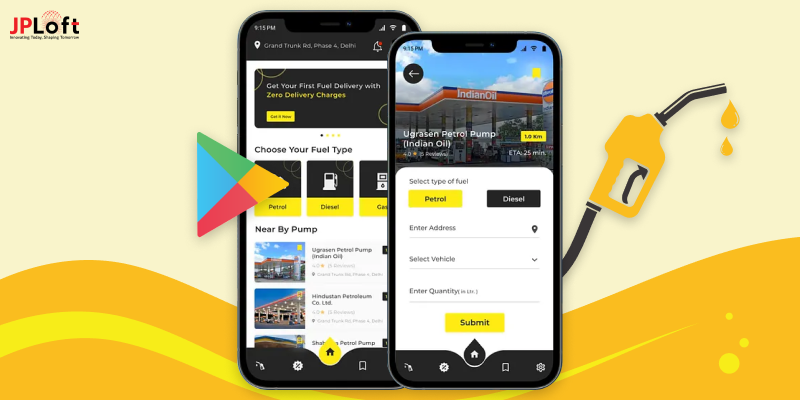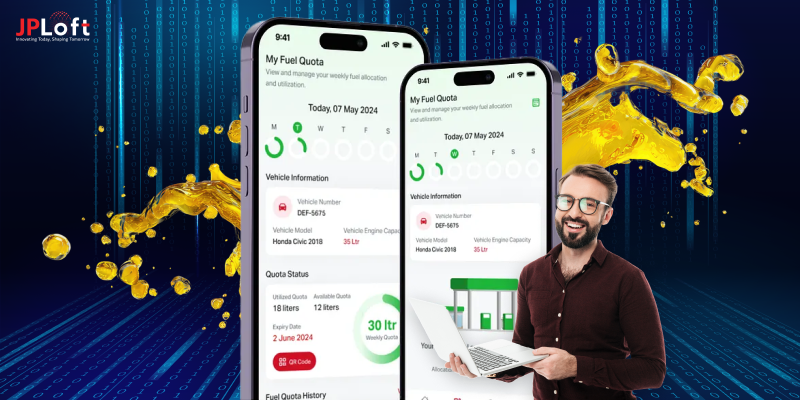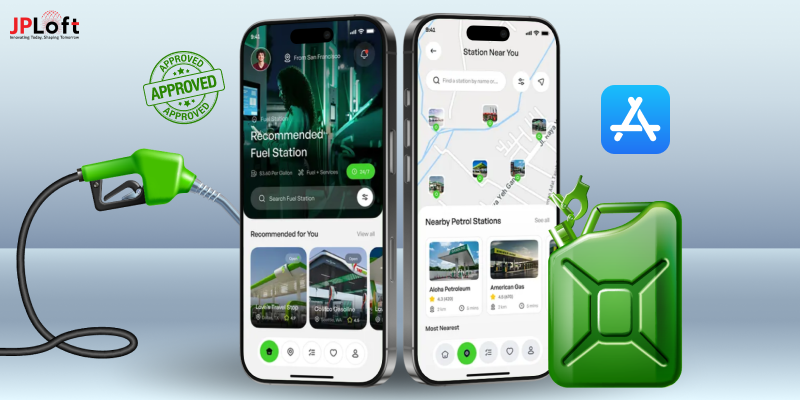Key Takeaways:
Green fuel delivery apps make clean energy easier to access and help users cut emissions effortlessly.
These apps solve major logistics issues by enabling fast, on-demand refueling for fleets and households.
The top reasons to invest in a green fuel delivery app include rising market demand, strong scalability, and long-term growth potential.
AI improves delivery efficiency by optimizing routes, predicting demand, and reducing operational waste.
Investors gain from recurring revenue, B2B contracts, and supportive clean-energy policies.
The future of refueling is multi-fuel, data-driven, and aligned with global net-zero goals.
JPLoft empowers entrepreneurs with scalable, compliant, and smart green fuel delivery solutions.
The global mobile fuel delivery market is projected to grow from USD 5.84 billion in 2025 to USD 11.93 billion by 2035, that is reflecting a CAGR of 7.4% during the forecast period.
This shift toward clean energy is opening powerful opportunities for investors and entrepreneurs ready to build future-focused businesses.
As sustainable fuel adoption accelerates, many are asking: What are the top reasons to invest in a green fuel delivery app?
The answer is clear. A green fuel delivery platform gives users instant access to eco-friendly fuels, solves major logistics challenges, and aligns perfectly with global sustainability goals.
It also supports recurring revenue, B2B partnerships, and multi-fuel scalability. Let’s learn the reasons in detail in this guide.
What is a Green Fuel Delivery App?
A green fuel delivery app is a digital platform where users, businesses, and fleet operators can order eco-friendly fuels such as biofuels, hydrogen, electric charging, biogas, or synthetic fuels through a mobile app or a web dashboard.
As opposed to going all the way to fueling stations, users can request on-demand refueling at any location of their preference. Such functionality reduces unnecessary vehicle movements, saves time, and decreases carbon emissions accordingly.
Using real-time geotracking, digital payment methods, route optimization, and safety compliance ensures safe and certified delivery.
Many of them also show sustainability metrics: how much pollution one has prevented by going greener with their fuel.
Advanced platforms incorporate AI and IoT in order to track fuel levels, place recurring deliveries, and predict usage. Companies looking to build such sophisticated systems often seek dedicated developers for hire who specialize in integrating these technologies seamlessly.
Green fuel delivery applications enable smart cities, sustainable logistics, and ESG-focused companies to reduce their footprint. Overall, they represent the future of clean mobility by making sustainable energy accessible, convenient, traceable, and data-driven.
The Market Shift Towards Sustainability, On-Demand Culture, and ESG Pressure
The global renewable energy market is expected to grow from USD 1.26 trillion in 2025 to USD 4.60 trillion by 2035, at a CAGR of 12.48% during the forecast period till 2035.
Additionally, the growing need for data-driven, scalable, and efficient environmental solutions is fueling the green technology, as well as the sustainability market, which is further expected to reach USD 73.90 billion by 2030, with a 23.7% CAGR.
With this data, it can be analyzed that a market shift has been observed towards sustainability, on-demand culture, and ESG Pressure. People are more inclined towards sustainability options.
Three powerful forces are now reshaping how people and businesses think: sustainability, on-demand expectations, and rising ESG pressure.
People want more green energy options, and they want it now. Businesses are under watch from investors, regulators, and even their own users to cut emissions, stay transparent, and be responsible operators.
Put them all together, and you get a market in which green fuel delivery isn't a nice-to-have but a must-have option for any brand that wants to stay relevant and future-ready. Let’s discover more about the shift towards sustainability from the following points.
1. Sustainability is Becoming a Core Growth Driver
Consumers, enterprises, and governments are moving towards cleaner mobility, net-zero goals, and a smaller dependence on fossil fuels.
Green fuel delivery aligns with climate commitments while keeping convenience intact. Those companies investing early enjoy long-term regulatory and brand advantage.
2. On-Demand Culture Shapes New Expectations for Services
People expect to have everything from food to cabs, healthcare, and fuel delivered to them instantly, without the constraint of location or time. Green fuel delivery fits into this shift through the integration of doorstep convenience with eco-friendly energy options for fleets, residents, and commercial sites.
3. ESG Pressure to Redefine Business Models and Investments
Enterprises are now measured on environmental, social, and governance impact, not just profitability. Green fueling helps organizations demonstrate carbon reduction, compliance, and responsible innovation that improve investor confidence and procurement eligibility.
Hence, are you ready to build a fuel delivery app that is inclined towards sustainability?
Then, learning about the different types of fuels that you can deliver via app can provide you with clarity on the green fuels. Let’s check out the following section for more.
Types of Green Fuels that You Can Support Via App
When you start an online fuel delivery business, it is important to identify and clarify the different types of fuels that you can deliver via your app.
It will be effective for your business if your fuels are environmentally friendly. Hence, let's check out the list of different types of green fuels in the given section.
Type 1: Bio-Diesel
Biodiesel is made from vegetable oils, used cooking oil, and animal fats; it's one of the easiest green fuels to adopt because it functions in most diesel engines without heavy modification.
Customers frequently ordering biodiesel in bulk include businesses that operate delivery fleets, construction vehicles, or generators because it cuts their carbon output without disrupting daily operations.
Type 2: Ethanol (E10, E20, E85 blends)
Ethanol is derived from biomass such as corn, sugarcane, and farm waste. Besides being cleaner-burning than conventional petrol, it contributes to less greenhouse gas emissions.
Because they have the potential to clean the atmosphere of a lot of pollutants and decrease oil dependency, many countries are already pushing for E20 or E85 blends. The green fuel app will let users order ethanol blends tailored for their vehicles' needs.
Type 3: Bio-CNG / Renewable Natural Gas (RNG)
Bio-CNG is made by processing organic waste from farms, food processing units, and municipal waste systems. It boasts one of the lowest carbon footprints among fuels in service today.
Auto-rickshaws, taxis, buses, and commercial fleets increasingly prefer Bio-CNG because it supports circular economy practices and cuts fuel costs. An app can help users schedule quick refills, doorstep delivery, and bulk supplies.
Type 4: Green Hydrogen
Green hydrogen is generated through the splitting of water by renewable electricity. It's gaining attention globally as a zero-emission fuel for heavy trucks, factories, and future hydrogen-powered cars.
In its still emergent stages, early adopters are industries, logistics companies, and clean-energy startups that want on-demand access to hydrogen cylinders or liquid hydrogen.
Delivery apps can bridge that gap and help accelerate green hydrogen ecosystems. You can create a hydrogen fuel delivery app that delivers on-time fuel.
Type 5: Sustainable Aviation Fuel (SAF)
Already, airlines are using SAF to cut carbon footprints on both domestic and international routes. It's made from waste oils, agricultural residues, and even algae. Beyond the airports, SAF is entering the drone delivery and cargo sector.
Apps offering SAF delivery can support aviation companies, drone operators, and logistics hubs wanting quick access to cleaner fuel without procurement delays.
Type 6: HVO (Hydrotreated Vegetable Oil)
HVO is a premium renewable diesel manufactured from waste vegetable oils and animal fats. It boasts excellent engine compatibility, much higher cetane numbers, and drastically lower particulate emissions.
Companies whose operations depend on generators, construction machinery, or long-haul trucks favor HVO due to the stable performance at extreme temperatures. Doorstep HVO delivery makes its adoption easier across industries.
Type 7: E-Methanol / Green Methanol
Green methanol is manufactured by combining captured CO₂ with green hydrogen. It has become a rising star in shipping, marine transport, and heavy manufacturing.
As more ports and industries switch to low-carbon fuels, on-demand methanol delivery helps them stay compliant with the global emission standards. It is also gaining traction in backup power systems because it burns cleaner and reduces toxic pollutants.
Type 8: Propane (Bio-LPG / Renewable LPG)
Bio-LPG is derived from renewable feedstocks instead of fossil sources. It’s ideal for businesses and households needing cleaner cooking, heating, or small-scale power solutions.
Ordering an instant Bio-LPG refill through an app can minimize restaurant, café, food truck, and rural home downtime while moving their daily operations toward greener solutions.
Type 9: Renewable Electricity for Mobile EV Charging
Many green delivery platforms now operate mobile EV charging units powered by solar or wind energy.
Customers can request an emergency charge, schedule a charging session, or top up their EVs at home or the office without relying on coal-based grid power.
It’s one of the fastest-growing “green fuels” in urban areas that are shifting to electric mobility.
What's the Role of Artificial Intelligence in Green Fuel Delivery Apps?
AI in fuel delivery apps analyzes logistics, improves demand forecasting, enables real-time monitoring, and produces reports on emissions by facilitating the integration of alternative fuel vehicles.
However, when it comes to examining the role of AI and data in green fuel delivery, it will help you to optimize routes, help in real-time monitoring, and predictive demand forecasting. Let’s check out the complete role list in this section.
1] Load Balancing and Planning Network
With the help of AI algorithms, you can aggregate orders and intelligently balance loads across the fleet to ensure that the vehicles are utilized efficiently and the partially loaded trips are minimized.
2] Route Optimization
The AI-powered algorithms analyze vast amounts of real-time data, including traffic, weather conditions, and vehicle load, to determine the most fuel-efficient routes. AI helps in building the shortest, safest, and most efficient path for every trip.
3] Green Fleet Management and Predictive Management
With the help of AI, you can support the integration and efficient management of electric vehicles (EVs) and hydrogen-powered vehicles through optimizing charging/refueling schedules. The AI-driven predictive maintenance identifies potential equipment failures by minimizing downtime.
4] Enhances Transparency and Collaboration
The combination of AI and blockchain technology can build a secure and transparent supply chain. It does allow the stakeholders to verify the origin and quality of green fuels. It ensures sustainable and ethical practices that are followed throughout the supply chain.
5] Risk Detection and Safety Monitoring
AI does help in detecting anomalies such as sudden pressure changes in hydrogen tanks, unsafe driving patterns, or deviations from approved routes. This further helps to reduce accidents and maintain compliance with strict safety norms for the green fuel category.
6] Carbon Footprint Monitoring
AI tracks emissions across each delivery trip, vehicle type, and fuel category. This further gives companies a live dashboard that shows how much carbon they are saving. It also helps in generating the ESG reports and sharing verified sustainability metrics.
Now, as you move forward, let's evaluate the complete list of reasons to invest in a green fuel delivery app in the following section.
Reasons to Invest in a Green Fuel Delivery App (Core)
To convert your fuel delivery ideas into reality, it is essential to know the overall reasons to invest.
Let’s evaluate and learn all the related reasons to invest in a green fuel delivery app, below.
► Increasing Demand for Clean Energy Access
More and more people and organizations are moving to green fuel, such as biodiesel, Bio-CNG, hydrogen, and ethanol.
A delivery app smooths out this transition by facilitating access to their doorsteps without tiring waits or frustrating searches to find a vendor. As awareness about clean energy increases, platforms that make green fuel convenient will top user preference.
► Untapped Market Opportunity with High Growth Potential
With climate goals, government incentives, and strict pollution controls, the global green fuels market is growing rapidly.
A mobile app provides the chance to enter this growing sector at an early juncture and capture an engaged user base. Investors benefit from low competition and significant scalability over the long term, as very few players are offering green fuel delivery.
► Modern Consumer Shift Toward On-Demand Convenience
People now expect everything to come to their doorsteps instantly, from groceries to charging stations.
A green fuel delivery app meets these expectations by allowing customers to schedule or make emergency fuel drops quickly. Convenience creates loyalty and differentiates you from fuel stations dependent on physical visits.
► Strong Push From ESG and Sustainability Compliance
Companies are often facing pressure from investors and partners to reduce emissions and switch to cleaner sources of energy.
Offering green fuel through an app helps companies meet sustainability targets without operational disruption. It also allows your platform to be positioned as a partner that supports ESG reporting, emission tracking, and responsible sourcing.
► Operational Efficiency Through AI and Automation
Tech-driven systems minimize the effort of manual planning and decrease fuel wastage and vehicle idling time.
AI-powered forecasting, routing, and fleet optimization provide an improved efficiency in each delivery cycle, thus reducing operational costs while offering quality services.
► Multi-Fuel Distribution Under One Platform
A green fuel delivery application would let users place orders for biodiesel, Bio-CNG, ethanol blends, green hydrogen, or Bio-LPG without having to contact multiple dealers.
This model of a unified marketplace reduces friction points and unlocks multiple revenue streams for the business, building flexibility as new renewable fuels enter the market.
► High Retention Through Subscription and B2B Contracts
Commercial fleets, restaurants, factories, and logistics companies prefer to have a stable supply of fuel rather than making ad-hoc purchases.
Subscription plans and long-term B2B contracts create predictable monthly revenue. The app becomes a core utility tool for clients seeking uninterrupted access to green fuel.
► Lower Carbon Footprint and Brand Differentiation
Your focus on green fuels and smart logistics means your platform has a direct and tangible impact on improving air quality and sustainability.
People reward with loyalty those brands that clearly take their environmental stewardship seriously. This strengthens brand trust and boosts word-of-mouth growth.
► Government Incentives and Policy Support
Many regions offer tax benefits or subsidies for businesses that promote renewable fuels.
An app-based fuel delivery model helps you tap into these programs easily. Support from regulatory bodies for digital transparency makes scaling across states or countries even easier.
► Expansion into EV Charging and Renewable Ad-Ons
Once the app is established, you can expand your services into mobile EV charging, carbon tracking dashboards, or green energy analytics.
This opens a future-ready ecosystem, rather than single-service ventures. It's a way to ensure your platform stays relevant as renewable technologies continue to evolve.
Now, as we move ahead with the reasons, let's consider what the key dominant players are doing in the industry. How these players are evolving in this competitive market, let's check it out below.
Competitive Landscape: How Leading Players Are Evolving
Learning about the real-world case studies and top fuel delivery apps provides a practical landscape to help you deal with the sustainable options and capture growing market demands based on sustainable fuel measures.
Let’s learn about the top players in the green fuel, below.
1. Booster (USA)
Booster began life as an on-demand fuel delivery service for fleets but has today positioned itself more as a decarbonization partner.
It delivers renewable diesel and biodiesel directly to vehicles and has partnered with Renewable Energy Group to scale sustainable fuel delivery for fleets across the US.
The company also speaks openly of lowering lifecycle emissions and is exploring a broader mix of alternative fuels plus EV-focused services and analytics.
2. EzFill (USA)
EzFill focuses on mobile fuel delivery but is framing this through the lens of sustainability. By optimizing delivery routes and reducing trips to petrol stations, they highlight lower CO₂ emissions and fewer ground spills compared to traditional self-serve models.
Recent communications from the company also position EzFill as part of the “energy transition,” with plans and messaging built around sustainable energy solutions, not just fuel drops.
You can develop an app like EzFill by identifying the potential need for biofuels and green energy fuels in the market.
3. Yoshi Mobility (USA)
Yoshi started with at-home and at-work fuel delivery and then became a more extensive mobility platform. Today, it leans heavily into mobile EV charging and green vehicle services, even spinning off part of its fueling division to put more focus on low-emission mobility.
Its shift shows where the market is going: from only petrol and diesel delivery to a blended model of charging, maintenance, and cleaner energy-first services.
You can evaluate the complete cost to build an App Yoshi after learning the diversified factors impacting this cost. Here, the diversified factors comprise of complexity of factors, complex app design, and many others.
4. ENOC Link / ADNOC & Regional Oil Majors (UAE and GCC)
In the Gulf, digital refuelling platforms such as ENOC Link, supported by ENOC, are scaling business mobile fuel delivery while publicly connecting such services to sustainability and operational efficiency.
Sustainability reports from ADNOC/ENOC do mention mobile fuel delivery in the context of cleaner operations, efficient routing, and reduced environmental impact, especially for enterprise fleets looking for transparent ESG reporting.
Continuing with the competitive landscape, you can explore diversified practices that you should know before investing in the green fuel delivery app. Hence, let's check out the following section for understanding it all in detail.
Best Practices to Consider Before You Invest in a Green Fuel Delivery App
If you want to proceed with the green fuel delivery apps, then identifying the effective best practices is an important determinant.
Following the best practices will help you to adequately conquer and pursue the fuel delivery app trends.
Let’s check out the best practices below.
A] Check Real Market Demand
Study how popular Bio-Diesel, Bio-CNG, Ethanol, Hydrogen, or Bio-LPG are in your target region. This will help you launch with the right fuels instead of simply making guesswork of what users may want.
Here, demand and supply are matched from day one, hence making your app grow faster and avoiding early operational waste.
B] Understand the Rules
Green fuel delivery is governed by strict safety, storage, and transport rules. Understand licensing, hazardous material laws, and compliance requirements before you go live.
This will protect your business from fines and help you function cleanly in a marketplace focused on sustainability.
C] Partner with Certified Suppliers
Reliable suppliers are more important than branding. Forge relationships only with certified producers who adhere to quality and sustainability standards.
By doing so, this will ensure businesses and fleet operators-who rely on you every day-get their supply of pure, stable, traceable fuel.
D] Providing Multiple Fuel Options
A single-fuel model restricts your reach. Selling biodiesel, Bio-CNG, hydrogen, ethanol blends, or Bio-LPG makes your app relevant to more industries.
A multi-fuel approach also reduces dependency on one product and expands your revenue potential.
E] AI for Smart Operations
An AI app development company can help you use AI to forecast demand, plan efficient routes, and balance fleet loads, all with minimal manual effort.
Smarter operations cut delivery times, reduce fuel waste, and keep your app profitable. It also differentiates you from older manually managed delivery systems.
F] Create a Clean and Transparent User Experience
Your application should make ordering easy, traceable, and trustworthy. Provide real-time delivery updates and clearly display pricing and safety information for each fuel type.
Transparency creates long-term loyalty, especially with the increasingly sustainability-conscious user base.
G] Emphasis on Safety and Training
Green fuels, such as hydrogen, methanol, and Bio-CNG, require special handling. Training the drivers, maintaining certified equipment, and adhering to strict SOPs are other crucial things.
Strong safety practices earn trust and help you win enterprise-level contracts that need flawless compliance.
With the above best practices, if you are still confused about the green fuel delivery app, then connecting with the leading mobile app development company can be helpful.
Let JPLoft Help You Craft a Winning Green Fuel Delivery App
Building a successful green fuel delivery app takes the right vision, the right technology, and a partner who understands sustainable mobility. You need a platform that’s fast, compliant, scalable, and designed for real-world operations.
JPLoft, a seasoned fuel delivery app development company, can help you turn a green fuel idea into a real, revenue-ready product. Our team works with you to define fuel types, user flows, fleet logic, and AI features like smart routing, demand forecasting, and carbon tracking.
We don’t just build an app; we design a complete platform that supports B2C users, fleet clients, and enterprise partners.
From compliance-ready architecture and secure payments to intuitive UX and scalable cloud infra, JPLoft makes sure your green fuel delivery app is fast to launch, easy to manage, and ready to scale with market demand.
Conclusion
Green fuel delivery apps are reshaping how individuals and businesses access clean energy. They bring convenience, transparency, and sustainability into one platform, making it easier for users to adopt eco-friendly fuels without disrupting their routines.
As the world moves toward net-zero commitments and greener mobility, investing in a green fuel delivery app positions you at the center of this shift. With the right technology, smart planning, and solid execution, you can build a future-ready solution that supports cleaner cities, efficient logistics, and long-term business growth.
FAQs
A green fuel delivery app can supply biodiesel, Bio-CNG, ethanol blends, hydrogen, Bio-LPG, SAF, and even renewable-powered mobile EV charging. This gives users and fleets multiple clean energy options in one place.
AI predicts demand, finds efficient routes, and balances fleet loads to cut waste and speed up deliveries. It also improves safety by tracking vehicle conditions and fuel parameters in real time.
Yes, when supported with certified tanks, trained drivers, and strict SOPs. Real-time pressure monitoring and temperature checks ensure hydrogen and other sensitive fuels are handled safely throughout the trip.
Businesses gain more through bulk orders, recurring deliveries, and ESG reporting tools. Fleets avoid downtime with predictable supply, while individuals enjoy simple, on-demand refueling at their location.
Profitability increases with rising clean-energy adoption, government incentives, and B2B contracts. Multi-fuel offerings and AI-driven logistics help reduce operational costs and increase long-term margins.
Yes, a scalable architecture lets you add new fuels, mobile EV charging, carbon dashboards, and AI-powered analytics. This flexibility keeps your platform future-ready as green energy evolves.
A green fuel delivery app meets rising demand for clean energy, supports new on-demand habits, and aligns businesses with ESG goals. It opens multi-fuel revenue streams, strengthens brand differentiation, and gives early movers a strong advantage in a fast-growing market.













Share this blog